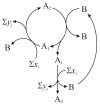A new replicator: a theoretical framework for analysing replication
- PMID: 20219099
- PMCID: PMC2850328
- DOI: 10.1186/1741-7007-8-21
A new replicator: a theoretical framework for analysing replication
Abstract
Background: Replicators are the crucial entities in evolution. The notion of a replicator, however, is far less exact than the weight of its importance. Without identifying and classifying multiplying entities exactly, their dynamics cannot be determined appropriately. Therefore, it is importance to decide the nature and characteristics of any multiplying entity, in a detailed and formal way.
Results: Replication is basically an autocatalytic process which enables us to rest on the notions of formal chemistry. This statement has major implications. Simple autocatalytic cycle intermediates are considered as non-informational replicators. A consequence of which is that any autocatalytically multiplying entity is a replicator, be it simple or overly complex (even nests). A stricter definition refers to entities which can inherit acquired changes (informational replicators). Simple autocatalytic molecules (and nests) are excluded from this group. However, in turn, any entity possessing copiable information is to be named a replicator, even multicellular organisms. In order to deal with the situation, an abstract, formal framework is presented, which allows the proper identification of various types of replicators. This sheds light on the old problem of the units and levels of selection and evolution. A hierarchical classification for the partition of the replicator-continuum is provided where specific replicators are nested within more general ones. The classification should be able to be successfully applied to known replicators and also to future candidates.
Conclusion: This paper redefines the concept of the replicator from a bottom-up theoretical approach. The formal definition and the abstract models presented can distinguish between among all possible replicator types, based on their quantity of variable and heritable information. This allows for the exact identification of various replicator types and their underlying dynamics. The most important claim is that replication, in general, is basically autocatalysis, with a specific defined environment and selective force. A replicator is not valid unless its working environment, and the selective force to which it is subject, is specified.
Figures













Similar articles
-
Theoretical Analysis of a Self-Replicator With Reduced Template Inhibition Based on an Informational Leaving Group.J Mol Evol. 2016 Mar;82(2-3):93-109. doi: 10.1007/s00239-016-9733-0. Epub 2016 Mar 22. J Mol Evol. 2016. PMID: 27002711
-
The evolution of replicators.Philos Trans R Soc Lond B Biol Sci. 2000 Nov 29;355(1403):1669-76. doi: 10.1098/rstb.2000.0730. Philos Trans R Soc Lond B Biol Sci. 2000. PMID: 11127914 Free PMC article.
-
Selection advantage of metabolic over non-metabolic replicators: a kinetic analysis.Biosystems. 2010 Feb;99(2):126-9. doi: 10.1016/j.biosystems.2009.10.005. Epub 2009 Oct 27. Biosystems. 2010. PMID: 19874865
-
Evolutionary dynamics of RNA-like replicator systems: A bioinformatic approach to the origin of life.Phys Life Rev. 2012 Sep;9(3):219-63. doi: 10.1016/j.plrev.2012.06.001. Epub 2012 Jun 13. Phys Life Rev. 2012. PMID: 22727399 Free PMC article. Review.
-
Evolution of RNA-Based Networks.Curr Top Microbiol Immunol. 2016;392:43-59. doi: 10.1007/82_2015_470. Curr Top Microbiol Immunol. 2016. PMID: 26336964 Review.
Cited by
-
Multilevel selection as Bayesian inference, major transitions in individuality as structure learning.R Soc Open Sci. 2019 Aug 28;6(8):190202. doi: 10.1098/rsos.190202. eCollection 2019 Aug. R Soc Open Sci. 2019. PMID: 31598234 Free PMC article.
-
Primitive Dark-Phase Cycle of Photosynthesis at the Origin of Life.J Mol Evol. 2018 Apr;86(3-4):167-171. doi: 10.1007/s00239-018-9840-1. Epub 2018 Apr 5. J Mol Evol. 2018. PMID: 29623351
-
Ecology and Evolution in the RNA World Dynamics and Stability of Prebiotic Replicator Systems.Life (Basel). 2017 Nov 27;7(4):48. doi: 10.3390/life7040048. Life (Basel). 2017. PMID: 29186916 Free PMC article. Review.
-
Towards an evolutionary theory of the origin of life based on kinetics and thermodynamics.Open Biol. 2013 Nov 6;3(11):130156. doi: 10.1098/rsob.130156. Open Biol. 2013. PMID: 24196781 Free PMC article. Review.
-
Endosymbiosis before eukaryotes: mitochondrial establishment in protoeukaryotes.Cell Mol Life Sci. 2020 Sep;77(18):3503-3523. doi: 10.1007/s00018-020-03462-6. Epub 2020 Feb 1. Cell Mol Life Sci. 2020. PMID: 32008087 Free PMC article. Review.
References
-
- Aunger R, (ed) Darwinizing Culture: The Status of Memetics as a Science. Ch. 1. Oxford: Oxford University Press; 2000. Introduction; pp. 1–25.
-
- Aunger R. The Electric Meme: A New Theory of How We Think. New York: The Free Press; 2002.
-
- Dawkins R. The Selfish Gene. Oxford University Press: Oxford; 1976.
-
- Dawkins R. The Extended Phenotype. Oxford University Press: Oxford; 1982.
-
- Godfrey-Smith P. The replicator in retrospect. Biol Phil. 2000;15(3):403–423. doi: 10.1023/A:1006704301415. http://www.springerlink.com/content/h05241v57m510r7t/ - DOI
Publication types
MeSH terms
LinkOut - more resources
Full Text Sources

